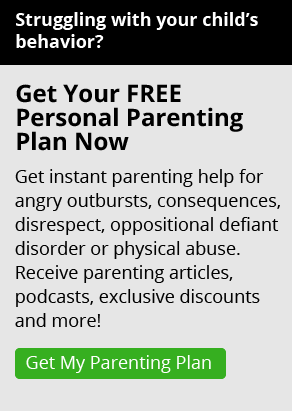Why are your child’s “triggers” so important to be aware of when it comes to losing your temper, or your kids acting out? Many parents I talk to in eCoaching are mystified by their child’s behavior. They feel like they’re walking through a minefield at home—where something, anything, could set their child off at any moment. This is an incredibly tough feeling for parents to deal with, and many feel at a loss about how to stop it; as a result, they feel defeated and hopeless. However, it is possible to turn things around.
It’s not the situation or the feeling that’s the problem; it’s how kids think about these things and what they say to themselves that causes problems.
In order to come up with a solution that will help, it’s important to first figure out what the problem is—what sets your child off? Once you identify your child’s “triggers,”—the events or situations that precede a tantrum or tirade, you’ll be on your way to stopping the out of control behavior.
To explain it in terms of behavior management, a trigger is a thought about a situation that leads to an inappropriate response to that situation. In other words, it’s not the situation or the feeling that’s the problem; it’s how kids think about these things and what they say to themselves that causes problems. Whenever a child lacks the skills to effectively respond to or manage a trigger, acting out occurs. For example, your teen might become angry and think to himself, “This is so unfair! I don’t have to put up with this crap.” This kind of thinking, commonly referred to as “negative self-talk,” might lead to your child lashing out, screaming, and throwing things. Some kids act out more passively; your child might pretend he doesn’t hear you when you ask him to do something, for example. What he might be saying to himself in this situation is, “She can’t control me. I can do whatever I want,” right before he decides to ignore you. Kids can also act in—they can withdraw and shut down or refuse to speak to you when you try to find out what’s wrong. They might think, “I’m so useless. I never do anything right. There’s just no point in trying.”
Learning your child’s triggers is one of the first steps to helping him learn better self-management skills. When he’s able to learn his triggers, he’ll start to recognize them when they come up. Only when he recognizes them can he start to use a new strategy to manage them. The process itself will involve a lot of problem-solving discussions with you and will take repetition and time, but it’s something most kids can learn.
How can you identify your child’s triggers?
Observe and Investigate: Observation is one of your best tools for identifying your child’s triggers, especially with younger children who have less self-awareness. Simply pay attention and be aware of the warning signs. Watch and listen, whether your child is hanging out with friends at home, doing homework, or playing on the playground. You might start to notice patterns emerging. For example, maybe your child does well with her math homework but starts to get sassy and restless when it’s time to do her daily reading. That would alert you that there may be a trigger related to reading that you want to explore more. Or, you might notice that your teen starts acting strange and moody after she talks to her boyfriend on the phone or returns from his house. This might tell you that the trigger is related to something going on in their relationship. Keep your eyes and ears open at all times and look for patterns and connections. And remember, observing is not the same as searching. If you are going to search through your child’s room, social networking accounts, backpacks, etc. be up front with them and let them know that you might search through these things at any time for any reason. [Editor’s note: For more on this subject, read Teens and Privacy by James Lehman, MSW.]
You also should enlist the help of other adults in your child’s life to observe your child’s behavior and interactions. This could include your relatives, other parents, or your child’s teachers. If your child starts acting out while other adults are around, ask them what they saw happen right before the acting out started. If your child acted out in school, find out what the teacher saw happening or what other students reported to her. You can think of yourself as an investigator interviewing the witnesses so that you can piece everything together and start to make connections between environmental factors and your child’s acting out. Observation by you and other adults in your child’s life is especially important when dealing with younger children (preschool through early elementary school) who might have a hard time answering any questions you ask them to clarify what happened. As helpful as this tool can be, do not rely on observation alone. Instead, let it serve as a guide that points you in the right direction.
Perception is Everything: It’s vital to consider your child’s perception of the incident. Remember that children perceive things very differently from adults. You might assume you know what happened, but your child probably experienced it very differently. So ask him about it even if you think you know the answer. You might say “What were you thinking right before you threw your book at your friend?” or “What was going on for you before you pushed that kid in the hall at school?” (Again, some younger children might struggle to answer these questions, but it can’t hurt to ask.) Some kids can have trouble putting their thoughts into words at times. If your child is still wound up from the incident, give him time to calm down before trying to have any sort of conversation about what happened. Emotions can sometimes be a block to clear, rational thought.
Here are 5 tips to help you make your child more aware of their triggers:
- With younger kids, talk about feelings: Because feelings and triggers are directly related, having discussions about feelings when your kids are young can help you establish a foundation to build on when identifying your child’s triggers for him. This should be done when things are calm and going well, not right in the middle of or after a tantrum or outburst. Ask your child what makes him angry. What makes him happy? What makes him sad? The purpose of this is to teach kids how to identify various feelings, to learn what it means to feel angry, happy, sad, disappointed, etc., not to give them an excuse for bad behavior. This also enables kids to communicate their feelings to you clearly so that you are in the best position to help them learn how to cope.
- Connect the dots for them: Let your child know what you have observed about the trigger and the acting out behavior. Use this as a framework: “Whenever ______ happens, you ________” or “I’ve noticed that when you ________, you __________.” For example, you might say “I’ve noticed that when you think something is unfair, you get verbally abusive and call me names. “ By connecting the dots for them, you are helping them learn their triggers. It’s best if this is part of a problem-solving discussion that includes you and your child coming up with a plan for what your child will do differently next time he is in this kind of situation. Having a clear simple plan is necessary to help your child change his behavior in the future.
- Talk about the signs: Often there are physical symptoms that come along with these trigger thoughts. The nervous system kicks into high gear when a trigger is present and can cause rapid heartbeat, warm flushed cheeks, rapid breathing, cold hands, muscle tension, and a lot of other signals. Ask your child what they feel in their body when the trigger you are talking about is present. When kids are aware of the warning signs their body gives them, it will serve as a natural cue to put the new plan you came up with during your problem-solving discussions into action.
- Cueing: Cueing is a common behavior management technique. Choose one specific trigger to work on and then come up with some kind of hand signal or phrase that will serve as an alert to your child that the trigger is present. This allows you to make your child aware of the trigger subtly in social situations. Once you have alerted him, he’ll have the chance to self-correct, or in other words, respond using the new plan you came up with, with minimal help from you. Cueing works at home as well.
- Check in: If you’ve cued your child but he didn’t use the response the two of you had planned on, have him take a break from whatever is going on and come speak to you in a quiet place, away from an audience. This is where you step in and help your child correct his behavior. Let him know you gave him the cue but you noticed he didn’t respond the way you had discussed. Remind him of what you talked about and let him know what the consequences will be if he doesn’t use the plan the next time you cue him today, and remind him what the plan is. This can apply with younger kids and teens, in social settings or at home.
What changes in behavior might you see?
Teaching your child about his triggers is not an easy process by any means. To really help your child become aware of his triggers takes time and repetition, as well as commitment and persistence on your part. Talking about it only one time and then forgetting about it will not get you anywhere; continuing to have calm, supportive and open dialogue about triggers is the key. Stick with it and allow room for some trial and error when coming up with new ways to respond to triggers. With time, most children not only learn how to respond more effectively when triggers occur, but they learn to anticipate them and even avoid situations that might set them off. As James Lehman says in the Total Transformation Program, “…Kids start to see triggers as real things that they can manage with real tools, that there are things you can do about this… But the bottom line is a lot of these kids’ minds construct ways of thinking that justify inappropriate behavior. And they’ve got to come up with alternative ways of thinking, alternative ways of perceiving the problem.”
When your child realizes there are things he can do to manage his triggers appropriately, your pay-off is a child who knows himself well, has improved self-management skills, and feels more confident about himself. And when you’re able to help your child reduce his acting out behavior, you’ll feel calmer and more in control—exactly how you want to be.
Related Content:
Acting Out in Public: Is Your Child’s Behavior Holding You Hostage?
Managing Your Child’s Meltdowns and Tantrums
About Sara Bean, M.Ed.
Sara Bean, M.Ed. is a certified school counselor and former Empowering Parents Parent Coach with over 10 years of experience working with children and families. She is also a proud mom.
You must log in to leave a comment. Don't have an account? Create one for free!


